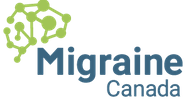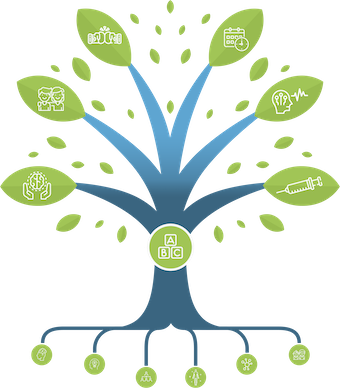Top Ten Facts about the neck and migraines
In humans, the head and the neck pain networks are linked and can cross-talk
The sensation of the face, head, sinuses, teeth, jaw are carried through the trigeminal nerve (V1, V2, V3). The sensation of the neck and upper shoulder are carried through the cervical nerves (C2, C3, C4).
Both networks connect in the same place (trigeminal nucleus), on the same neurons.
The human anatomy explains why head pain and neck pain are often related. A neck problem can cause headache, and a headache can cause neck pain
60% of migraine patients (with no neck issues otherwise) report neck pain during a migraine
Neck pain and tension during a migraine is reported since Antiquity up to this day. It is as common as nausea. This means that migraine can cause neck pain even if the neck is perfectly normal.

Imaging tests of the neck are most of the time useless
All joints age with time. Dry disks, arthrosis in joints, bad alignment of vertebrae, abnormal ligaments etc can be seen in perfectly normal people with no neck pain. The imaging results cannot predict response to injections either. Sometimes things seen on MRIs lead to a lot of useless anxiety and even more useless tests.
Patients and health care providers really want to «see something» to explain the pain, but imaging is costly and rarely useful.
Many structures in the neck can cause pain but it’s difficult to investigate and examine
The neck is a very complex structures with joints, tendons, ligaments and muscles, all of which could in theory become inflamed and cause pain. This being said, the value of imaging is very limited, and the clinical examination, even by an expert physio, does not always provide clear answers.
Cervicogenic headache is often time post-traumatic (caused by a trauma)
A big problem with cervicogenic headache is that the Classification does not reflect reality. In real life, most people with cervicogenic headache have had a trauma (concussion, traumatic brain injury, whiplash) or repeated micro-trauma (head posture at work, repeated movements). Post-traumatic headaches are a mixed bag of different types that should be more clearly defined. Patients should be aware of this, as it can explain some of the confusion they might encounter in different clinics.
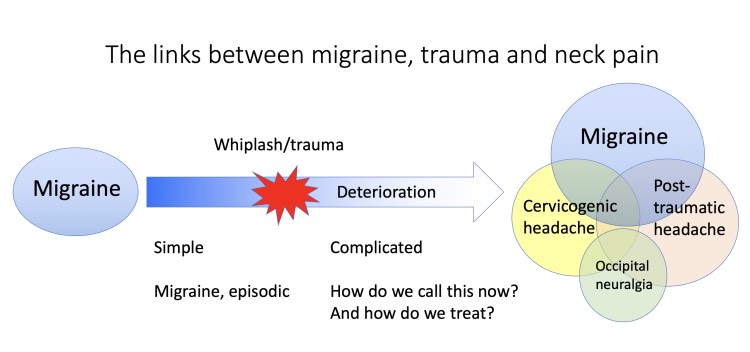
The neck, the ear and the jaw pain networks are closely related
A neck problem can cause jaw pain, a tooth problem can cause ear pain, a pain in the ear can radiate to the throat. Once again, being aware of the pain networks and wiring of the head helps to understand symptoms.
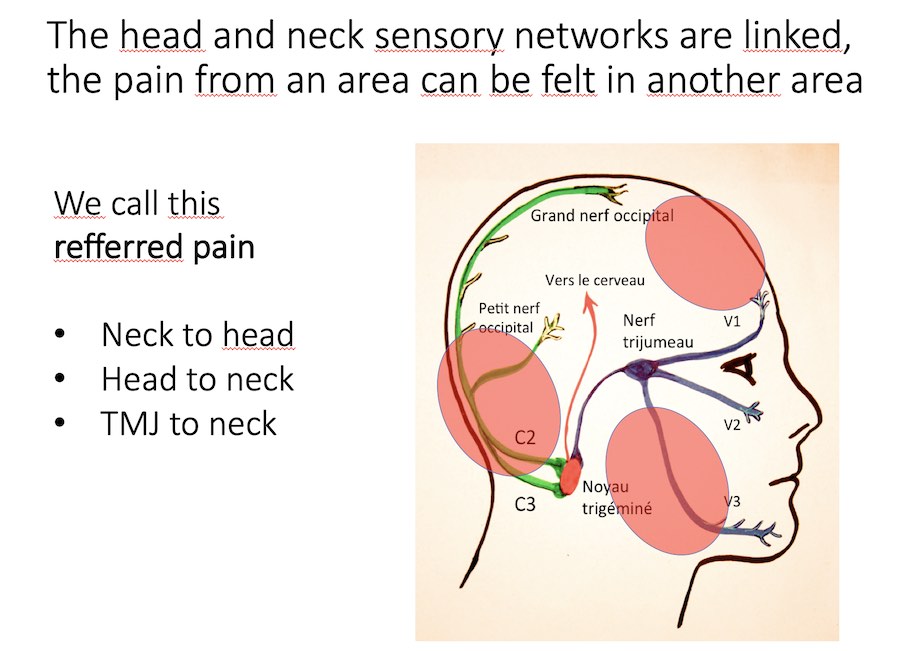
Medications can help with neck pain and headache but are rarely sufficient
Nobody wants to live with chronic neck pain. Different medications can help with chronic pain in general, including tricyclics (amitriptyline), muscle relaxants (cyclobenzaprine), gabapentinoids (gabapentin, pregabalin), NSAIDS (ibuprofen, naproxen, celecoxib) and of course opioids (oxycodone, hydromorphone). Their benefits cannot be ignored, but most of these medications come with habituation, side effects, dependence and even addiction.
Injections in the neck might work, but their effect can be placebo
We all wish that we could turn the pain down with injections. Ideally, we could predict who will respond to nerve blocks, facet blocks, trigger point injections, but we really can’t. Injections are associated with a high placebo response (as much as 40%), therefore improvement after injections does not always mean that the target was the cause of the pain. (See this post)
Nevertheless, injections can still be helpful. Botox may help for chronic migraine, and sometimes has a clear effect on neck pain. Botox may also weaken muscles, and the injections should be done carefully to avoid neck and shoulder weakness that can deteriorate posture on the long term.
Strengthening neck and shoulders muscle can be done, but slowly and with competent help
Our sedentary lifestyle does lead to back pain and neck pain because our posture muscles become weak. Bad posture can lead to pain and migraines. So what can you do about it? Forget magic devices, TENS machines, straps and massage. Those passive techniques will not strengthen your muscles. Only regular exercise that you do will do this. If you have pain and are not used to exercise, seek the help of a physiotherapist. Plan for 3 to 6 months before seeing benefits. (See this post)
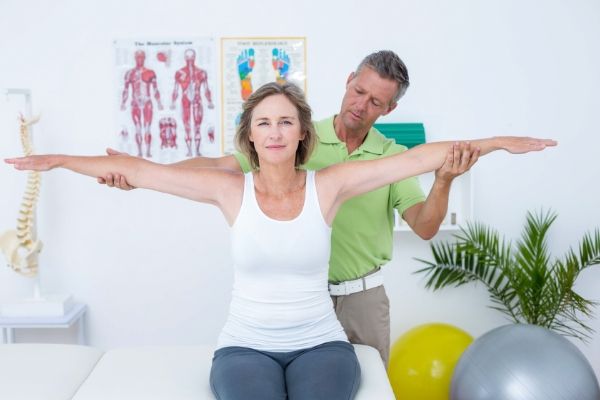
Neck pain and back pain are very frequent and should be addressed with a long term vision
Humans nowadays live longer lives and are more sedentary. Is this better than dying at 40 after 30 years of working hard in a corn field? Probably, but it comes with consequences on our joints. People also practice more sports and drive cars and motorcycles, therefore have more accidents.
Statistics from the World Health Organization demonstrate that neck pain, back pain and migraines are extremely common and disabling. Research shows that post-traumatic headache is difficult to treat, that opioids lead to problems and that injections do not cure everyone. Therefore, expectations must be settled in the «realistic» mode and a global approach should be adopted, including exercises and stretches. Relief can usually be found.
You have only one spine, take good care of it!
REFERENCES
Calhoun AH et al. The prevalence of neck pain in migraine. Headache. 2010; 50(8):1273-7.
Bogduk N, Govind J. Cervicogenic headache: an assessment of the evidence on clinical diagnosis, invasive tests, and treatment. Lancet Neurol. 2009;8(10):959-68.
Post#411
Tags In
Categories
THE MIGRAINE TREE
- BRANCHES
- ACUTE TREATMENTS
- DEVICES AND NEUROMULATIOIN
- PREVENTIVE TREATMENTS
- PROCEDURES AND INJECTIONS
- SELF-CARE AND LIFESTYLE
- SOCIAL LIFE
- TRUNK
- ROOTS
OTHER CATEGORIES
